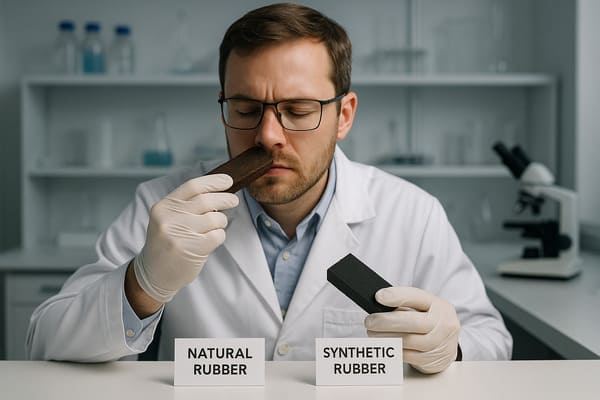Are you unsure whether the rubber you're dealing with is natural or synthetic? Understanding the differences between natural and synthetic rubber is crucial for selecting the right material for your application. Let’s explore the methods for identifying the type of rubber you’re working with.
You can identify rubber as either natural or synthetic by performing simple tests such as observing its smell, elasticity, and conducting a burn test. However, for definitive results, laboratory testing methods like FTIR are recommended.

It’s important to distinguish between natural and synthetic rubber, as each type has unique properties suited for different applications. Here are some practical methods for identifying the rubber material, ranging from simple observations to advanced laboratory tests.
What Is Natural Rubber?
Natural rubber, also known as latex rubber, is harvested from the sap of rubber trees. Let’s understand its unique properties and how you can identify it.
Natural rubber is derived from rubber tree sap (Hevea brasiliensis). It’s known for its elasticity, high tensile strength, and quick recovery after stretching.
Natural rubber1 is obtained from the latex of rubber trees. The sap is harvested and processed to create rubber that has exceptional elasticity and resilience. It's widely used in products that need to be flexible, durable, and capable of returning to their original shape after being stretched. Applications like tires, seals, and medical gloves commonly use natural rubber.
Key Features of Natural Rubber:
- Elasticity2: Natural rubber has excellent elasticity, making it ideal for applications that require flexibility and stretchability.
- Tensile Strength3: It offers high tensile strength, which allows it to withstand stretching forces.
- Odor: Natural rubber has a characteristic latex smell, especially in its raw form.
Identifying Natural Rubber:
- Smell: Natural rubber has a distinctive rubbery or slightly sweet smell.
- Elasticity: Natural rubber stretches easily and quickly returns to its original shape when released.
What Is Synthetic Rubber?
Synthetic rubber is made through chemical processes and often mimics the properties of natural rubber. Let’s explore its characteristics and how to identify it.
Synthetic rubber is made from petroleum-based chemicals and is often used in applications requiring resistance to oil, chemicals, or high temperatures.

Synthetic rubber is produced by polymerizing monomers, typically derived from petroleum-based chemicals. There are several types of synthetic rubber4, including butadiene rubber (BR), styrene-butadiene rubber (SBR), and nitrile rubber (NBR). These rubbers are specifically designed to meet particular requirements, such as oil resistance, weather resistance, and temperature tolerance.
Types of Synthetic Rubber:
- SBR (Styrene-Butadiene Rubber)5: Common in automotive tires.
- NBR (Nitrile Rubber)6: Known for its oil and fuel resistance, commonly used in seals and gaskets.
- EPDM (Ethylene Propylene Diene Monomer): Used in roofing and automotive applications due to its resistance to weathering.
Identifying Synthetic Rubber:
- Smell: Synthetic rubber often has a more chemical or gasoline-like smell, especially for types like SBR and Neoprene.
- Elasticity: While synthetic rubber can mimic natural rubber’s elasticity, it may not stretch as far or return as quickly.
What Are the Key Differences Between Natural and Synthetic Rubber?
What sets natural rubber apart from synthetic rubber? Understanding their differences is crucial for selecting the best material for your needs.
Natural rubber excels in elasticity and resilience, while synthetic rubber is often chosen for its resistance to chemicals, oils, and higher temperatures.
Although natural and synthetic rubbers share similar basic properties, there are some key differences:
-
Elasticity:
- Natural Rubber: Known for its superior elasticity, natural rubber stretches easily and returns to its original shape rapidly.
- Synthetic Rubber: Elasticity varies greatly depending on the type of synthetic rubber. Some, like SBR, mimic natural rubber’s elasticity, while others may have less stretch.
-
Resistance to Chemicals and Temperature:
- Natural Rubber: Sensitive to oils, fuels, and extreme temperatures. It degrades faster in harsh environments.
- Synthetic Rubber: Certain types of synthetic rubber (like NBR or Viton) offer better resistance to oils, fuels, and high temperatures than natural rubber.
-
- Natural Rubber: Generally more expensive and less readily available due to its harvesting process.
- Synthetic Rubber: More affordable and widely available as it is produced using petroleum-based chemicals.
Comparison Table:
| Property | Natural Rubber | Synthetic Rubber |
|---|---|---|
| Elasticity | Excellent | Varies (depends on type) |
| Chemical Resistance8 | Poor (easily degrades in oils and fuels) | Excellent (especially in NBR, EPDM) |
| Temperature Resistance | Moderate (up to 80°C) | High (varies by type) |
| Cost | Higher | Lower |
| Applications | Tires, seals, gaskets | Automotive, industrial, medical |
What Are the Methods to Identify Natural vs Synthetic Rubber?
Want to know how to easily identify whether rubber is natural or synthetic? Let’s explore some simple tests you can conduct.
You can use methods such as the smell test, stretch test, and burn test to help identify whether rubber is natural or synthetic. Laboratory analysis is the most definitive method.

There are several ways to identify natural rubber versus synthetic rubber:
-
Smell Test: Natural rubber has a distinct latex smell, while synthetic rubber may have a more chemical or gasoline-like odor.
-
Elasticity Test: Stretch the rubber. Natural rubber will stretch more easily and return to its original shape more quickly than synthetic rubber.
-
Burn Test: Natural rubber burns with a sooty, yellow flame, producing a sweet odor. Synthetic rubbers have different burning characteristics, such as:
- SBR: Aromatic smell, sooty flame.
- NBR: Acrid smell, sputtering flame.
- Neoprene: Self-extinguishing, produces HCl fumes.
-
Acetone Test: Apply a small drop of acetone. Natural rubber will swell or become sticky, while synthetic rubber like silicone or EPDM resists acetone.
Conclusion
Identifying whether rubber is natural or synthetic involves a combination of simple tests, including smell, stretch, and burn tests. While natural rubber excels in elasticity and resilience, synthetic rubber offers better resistance to chemicals, oils, and high temperatures. The correct rubber type can be determined by understanding the specific performance requirements of your application.
🚀 Need Custom Rubber Solutions for Your Specific Application?
Contact Julong Rubber today or Request a Custom Quote for high-quality rubber products tailored to your needs!
Or reach out to us directly via WhatsApp:
-
Explore the diverse applications and advantages of natural rubber, from tires to medical gloves, to understand its significance in various industries. ↩
-
Learn how elasticity plays a crucial role in the performance of materials, particularly in applications requiring flexibility and durability. ↩
-
Discover the importance of tensile strength in materials, especially natural rubber, and how it contributes to their durability and performance. ↩
-
Exploring this resource will provide insights into the diverse applications and advantages of synthetic rubber in various industries. ↩
-
Discover the essential characteristics of SBR and its widespread use in automotive tires, enhancing your knowledge of rubber materials. ↩
-
This link will help you understand the unique properties of NBR and its critical role in manufacturing durable seals and gaskets. ↩
-
This information is crucial for budgeting and sourcing materials for projects involving rubber. ↩
-
Exploring this topic can guide you in choosing the appropriate rubber for environments with harsh chemicals. ↩









